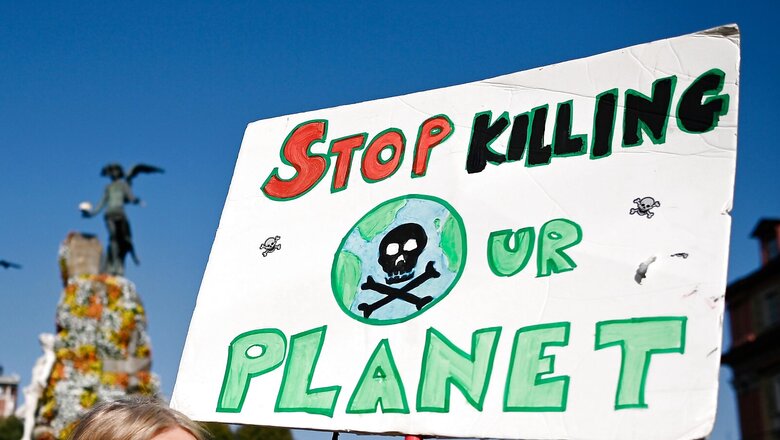
views
As world leaders gather in Glasgow on November 1-2 for the COP26 climate summit, bear in mind that the rich world became rich by polluting the world.
It is not a theme summit host British Prime Minister Boris Johnson will dwell on. Before the Industrial Revolution began in Britain in 1760, carbon dioxide (CO2) emissions were negligible. For the next 200 years, Britain, the rest of Europe and the United States industrialised, polluted the atmosphere and built their wealth.
Factories in Manchester spewed smoke; coal was mined in Newcastle; African slaves worked as bonded labour on plantations as America’s industrialisation gathered pace. Carbon emissions rose exponentially.
Having created modern, prosperous, industrialised societies, the West finally woke up to the problem of global warming in the 1970s. The first quasi-climate summit was held in Stockholm in 1972.
ALSO READ | COP26: With Developed World Not Doing Its Bit, India’s Case for Climate Justice is Strong
Known as the First Earth Summit, it focused on the environment. But the real impact of global warming hadn’t quite sunk in. It was only in 1987 that the UN General Assembly adopted what it termed the Environmental Perspective to the Year 2000. Since then climate change has increasingly become a hot-button global issue.
Since 1751, over 1.6 trillion tonnes of CO2 have been emitted. Which countries are the principal polluters? The United States has emitted 400 billion tonnes of CO2, a quarter of the cumulative global total. Next comes China with 200 billion tonnes of CO2, though much of that has been emitted in the past 40 years.
But the biggest polluter as a bloc — not a nation — is Europe. It has spewed 514 billion tonnes of CO2 in the atmosphere in the process of building an industrialised society.
India, the target of the rich world to cut its carbon emissions, has emitted 48 billion tonnes of CO2 since 1751 — just 3 per cent of the cumulative global total. The statistic also reveals how industrialisation in India was retarded by nearly 200 years of colonialism. Indian raw material was bought with Indian tax money, shipped to Britain, manufactured in carbon-polluting factories of Manchester, and shipped back to India to be sold at exorbitant prices.
Wealth flowed from India to Britain even as Britain industrialised at India’s expense, suppressed Indian industry, and began the process of global warming.
In Glasgow on November 1-2, over 150 global leaders will carve out a path to the future. Average temperatures today have already risen by 1.10 degrees Celsius over the pre-industrial average. The key issue is who should bear the principal burden of cutting carbon emissions? Historical polluters like the US and Europe? Or rising polluters like China and India? The answer obviously is both.
That is what the Glasgow COP26 summit should seek to achieve. Prime Minister Narendra Modi has long argued that India’s industrial development cannot be held hostage to unreasonable cuts in its carbon emissions.
Prime Minister Modi is, in fact, a climate change evangelist. He has written a book, Convenient Action: Gujarat’s Response To Challenges Of Climate Change, published by Macmillan in 2011, suggesting how the threat of global warming can be countered by a balanced reduction in carbon emissions without harming economic growth.
Two issues arise. The first is the $100 billion annual funding that developed countries — the world’s historical polluters — pledged to provide to developing countries to mitigate the developmental impact of meeting global warming goals. That money has not materialised. The rich world says it will start paying up only in 2023.
The second issue is India’s industrial development. India missed the bus to create an industrialised and prosperous nation during two centuries under British colonialism. India’s real industrial growth began only after Independence. The momentum cannot be allowed to be slowed just as it is reaching an inflexion point. That would have serious ramifications on reducing poverty, hunger and malnutrition.
“Net zero” or carbon neutrality as a target is ambitious but achievable for some. Around 50 countries — mostly from the rich, industrialised world which created the climate crisis in the first place — have pledged carbon neutrality by 2050.
Already industrialised, most are now service economies. Britain, for example, closed one of its last coal mines, The Bradley Mine in Durham, in August 2020. Services now account for 80 per cent of British GDP. Wealth already built, Britain can afford to achieve net zero.
Can India? PM Modi has argued strongly for climate justice. In essence, it means India will work towards reducing carbon emissions — which obviously is in India’s environmental interests — while keeping its development goals firmly in mind. India does not have the luxury of Europe or America to de-industrialise when it is still industrialising.
In 2019 (the latest year for which accurate data is available), China was the world’s biggest carbon emitter (10.2 billion tonnes) followed by the US (5.3 billion tonnes) and India (2.6 billion tonnes). In per capita terms, however, the US has the worst record, emitting 16.1 tonnes of CO2 per American. China emits 7.1 tonnes per person and India just 1.9 tonnes per person.
India has set a goal of generating 450 GW of renewable energy by 2030 along with several other measures, including its ambitious hydrogen mission, to move towards net zero emissions in a calibrated manner that does not hamper economic growth.
A group of 24 countries have, meanwhile, joined hands to reshape the narrative on climate change that has so far been controlled by the West. Dubbing themselves Like-Minded Developing Countries (LMDCs), the group (which includes both India and China along with Malaysia, the Philippines and others) issued this ministerial statement ahead of COP26: “Despite the lack of ambition shown in the pre-2020 period, as well as in the Paris Agreement NDCs (nationally determined contributions), major developed countries are now pushing to shift the goal posts of the Paris Agreement from what have already been agreed by calling for all countries to adopt Net Zero targets by 2050. This new ‘goal’ which is being advanced runs counter to the Paris Agreement and is anti-equity and against climate justice. Demands for ‘net zero’ emissions for all countries by 2050 will exacerbate further the existing inequities between developed and developing countries.”
The Industrial Revolution that helped the rich world acquire wealth would not have been remotely as successful without European colonialism of Asia and Africa and black slavery in America.
Action on global warming is critical but nations that have polluted the world for centuries must pay the price.
The writer is editor, author and publisher. The views expressed in this article are those of the writer and do not represent the stand of this publication.
Read all the Latest News , Breaking News and IPL 2022 Live Updates here.




















Comments
0 comment